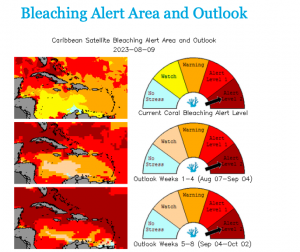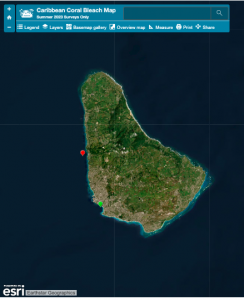| REGULAR MONITORING FOR EXTREME WARMING, OTHER WEATHER EVENTS – Caribbean Instititute for Meteorology and Hydrology Many services, links, among the: NOOA “Users apply NOAA CRW products to monitor and predict detrimental impacts to coral reefs worldwide; understand links between environmental conditions and ecosystem impacts; assess when reefs are vulnerable or resilient to warming ocean and its impacts (especially coral bleaching and disease); and prepare and prioritize resources to implement timely, effective protective responses and adaptation actions, thereby improving coral reef management and regulation…” AGGRA Coral Bleaching |
=========
Lab-grown corals resisted bleaching during Caribbean’s worst marine heat wave
Caitlin Cooper for Mongabay Highlights:
– In 2023, the Caribbean Sea experienced unprecedented heat: Beginning in March, sea surface temperatures throughout the region ranged from 1°-3°C (1.8°-5.4°F) warmer than normal.
– This unprecedented heat brought the worst coral bleaching event in the Caribbean’s recorded history, bleaching 60-100% of some reefs, and killing many patches.
– A new study found that certain species of coral propagated in the lab and then outplanted to restore reefs in five countries showed few signs of bleaching despite the prolonged marine heat wave, faring better than wild corals or corals propagated from fragments.
Mesophotic reefs offer thermal refuge to the 2023 Caribbean mass bleaching event in the Cayman Islands
Gretchen Goodbody-Gringley & Alex D. Chequer. 2025 In Nature Scientific Repports “Coral reefs are increasingly threatened by marine heatwaves, which drive widespread coral bleaching and mortality. Mesophotic coral ecosystems (MCEs) have been proposed as potential thermal refuges due to their greater depth and relative isolation from surface temperature extremes. Yet their resilience to extreme heat events remains uncertain, with location specific conclusions, thus requiring further studies. Here, we investigate the effects of the 2023 marine heatwave in the Cayman Islands, which resulted in prolonged sea surface temperatures exceeding 31 °C and 17.5 DHW with extensive bleaching across shallow coral reefs. Utilizing vertical transect surveys from 10 m to 50 m, we assessed depth-related variations in bleaching prevalence and temperature profiles. Our results indicate a significant decline in bleaching with increasing depth, with a concurrent reduction in temperature. Depth-generalist species exhibited reduced bleaching at greater depths, whereas shallow-water specialists displayed severe bleaching. These findings suggest that while MCEs may provide thermal refuge for some species, their capacity to buffer against climate-driven reef degradation is species-specific. Given the increasing frequency and intensity of marine heatwaves, understanding the role of deeper reef habitats in mitigating coral loss is critical for informing conservation and management strategies. Our study underscores the importance of protecting MCEs as potential thermal refuges while emphasizing the need for continued research on species-specific thermal resilience with depth.”
Large scale coral mortality in Barbados: a delayed response to the 2005 bleaching episode
H.A. Oxenford. R. Roach and A. Brathwaite Proceedings of the 11 th International Coral Reef Symposium, Ft. Lauderdale, Florida, 7-11 July 2008
Session number 16 ” Corals in Barbados suffered widespread bleaching during the high temperature event of 2005. Six reefs were monitored for one year (October 2005 – November 2006) to determine mortality impacts and rate of recovery from this bleaching event. Five 1 x 20 m band transects and five 20 m line transects were quantitatively surveyed at each site, every four months. Bleaching prevalence dropped from a mean of 71% of colonies in October 2005 to 38% in February, to 17% in June, before rising again to 25% in November 2006. Coral mortality remained low for five months (means: 3.8% colony surface dead; or 4.8% dead cover), but rose sharply after 10 months (means: 18.7% colony surface; or 25.9% cover), eventually declining after 15 months to near ambient levels (means: 2.0% colony surface; or 6.1% cover). Like other eastern Caribbean islands, recovery from bleached condition was slow and overall mortality impact was high on both deep and shallow reefs. In contrast were the delayed onset of mortality and low incidence of coral disease. High losses in live coral cover have significant economic implications for the island which derives a major proportion of its GDP from tourism, and relies heavily on healthy reefs for coastal protection.”
| High Water Temperatures/Coral Bleaching in Caribbean Summer-Fall 2023  From the August 2023 Caribbean Coral Reef Watch Bulletin Dying coral reefs demand Caribbean takes new approaches AGRRA Coral Bleaching Reports/Interactive Maps AGRRA refers to the The Atlantic and Gulf Rapid Reef Assessment Program.
Sep 2023: Largest, hottest, longest Caribbean bleaching: corals dying from extreme heat Caribbean sea coral bleaching 2023: Jamaica, Barbados, Belize Tracking Coral Bleaching Events Globally Using Reef Check |
Bleaching of the fire corals Millepora
William K. Fitt, Proceedings of the 12th International Coral Reef Symposium, Cairns, Australia, 9-13 July 2012 9A Coral bleaching and climate change “…Millepora complanata and M. alcicornis were among the first species to exhibit bleaching in the greater Caribbean during the 1973, 1982-3, 1987-88 El Niños ”
Response of Millepora alcicornis (Milleporina: Milleporidae) to two bleaching events at Puerto Morelos reef, Mexican Caribbean
Anastazia T. Banaszak et al. Rev. Biol. Trop., 51, Supl. 4: 57-66, 2003
Ecology, Biology and Genetics of Millepora Hydrocorals on Coral Reefs
Caroline E. Dubé et al., 2019.. FROM THE EDITED VOLUME Invertebrates – Ecophysiology and Management
Zooxanthellate hydrocorals are thought to be extremely sensitive to bleaching [130, 133] and can be threatened by future climate change. Millepora spp. have been reported to be among the first cnidarians to lose their zooxanthellae symbionts during widespread bleaching events [134] and they have suffered local or regional extinctions from bleaching in the Pacific [78, 85, 135]. Numerous investigations of bleaching events on Caribbean and Florida Keys reefs have reported bleaching of Millepora colonies [133, 136, 137, 138, 139], with M. alcicornis, a finely branched species, being the most severely affected reef corals. Such coral morphology has been described to be more susceptible to bleaching than encrusting and massive species [140]. Yet, bleached colonies of M. alcicornis remained alive during a bleaching event affecting a north-eastern Brazilian reef [133], which is in accordance with previous reports that Millepora species are also the first to recover from short-term bleaching [136, 137]. In the Maldives Archipelago (Indian Ocean), Millepora was reported to be the major reef-building coral in shallow reefs (7 m depth), producing some ‘Millepora zones’ [141]. Three species were well documented, the massive species M. cf. platyphylla [46, 142] and two branching ones, M. tenera [51, 143, 144] and M. latifolia [143]. However, many recent surveys of the Maldivian reefs have identified another pattern of distribution, where none to low abundances of Millepora species were recorded (1–2 depending on the species) [145, 146, 147, 148]. Gravier-Bonnet and Bourmaud [148] suggested that milleporids were extirpated from several Maldives atolls, following the 1997–1998 El-Nino Southern Oscillation event (ENSO). ENSO has induced a strong bleaching and massive coral mortality (of up to 90%) in the tropical Indian Ocean, including the Maldives [145, 149]. On the Great Barrier Reef, Millepora spp. were also the most susceptible taxa to the mass bleaching event of 1998, with 85% of mortality [130], while they showed no evidence of bleaching at Moorea, although scleractinian corals were severely bleached at this location [150]. During 2014–2017, the worst documented bleaching event observed [26, 27], M. cf. platyphylla showed no sign of bleaching at Moorea, although about 60% of scleractinian corals were bleached on the fore reefs (Figure 6A). Since February 2019, Moorea’s reefs are suffering from another mass bleaching event, with colonies of M. cf. platyphylla showing sign of bleaching and mortality (Figure 6B). Differential susceptibilities to this bleaching event were also observed between M. cf. platyphylla colonies (Figure 6C). Ongoing surveys will help quantifying bleaching susceptibility and mortality among coral taxa and locations, as well as between fire coral growth forms and genotypes (Dubé et al. in prep). Nevertheless, a previous study has shown that temperature is the primary factor related to bleaching in M. alcicornis, but that synergism with exposure to solar radiation may play a key role in hydrocoral bleaching [151]. Also, multifocal bleaching in hydrocorals, consisting of numerous scattered bleached spots, has been first described as a syndrome caused by an infectious disease affecting several colonies of M. dichotoma in the Red Sea [152]. 16S rRNA gene sequencing showed that affected tissues match sequences of bacteria belonging to Alphaproteobacteria and Bacteroidetes members previously associated with various diseases in scleractinian corals [153]. Yet the mechanisms of multifocal bleaching, its aetiology and mode of transmission remain unknown. Nevertheless, many studies have addressed the aetiology and effects of bleaching in Anthozoan species, wherein changes in the expression of genes and proteins were observed, and particularly heat shock proteins and transcription factors [154, 155, 156, 157, 158, 159]. A recent study demonstrated that bleached specimens of M. alcicornis in Mexican Caribbean undergo a moderate decrease in symbiont’s density and photosynthetic pigments, in addition to differential expression of 17 key proteins, such as calmodulin, actin and collagen often coupled with calcium homeostasis, exocytosis and cytoskeleton organization in Anthozoan species [139].

